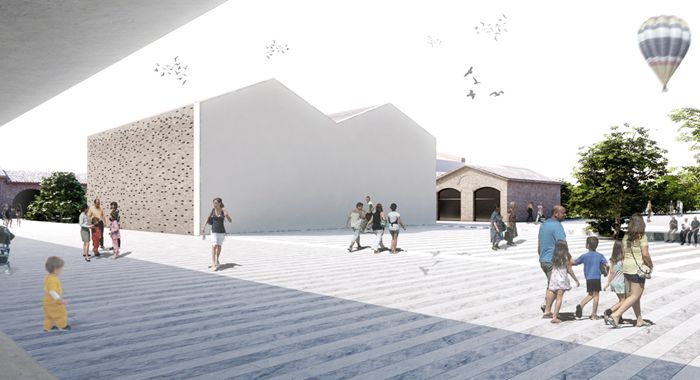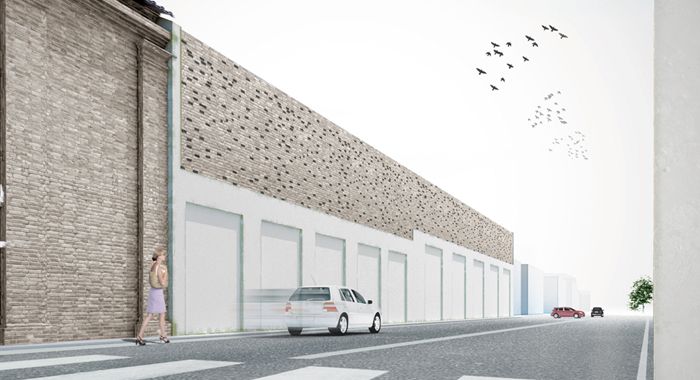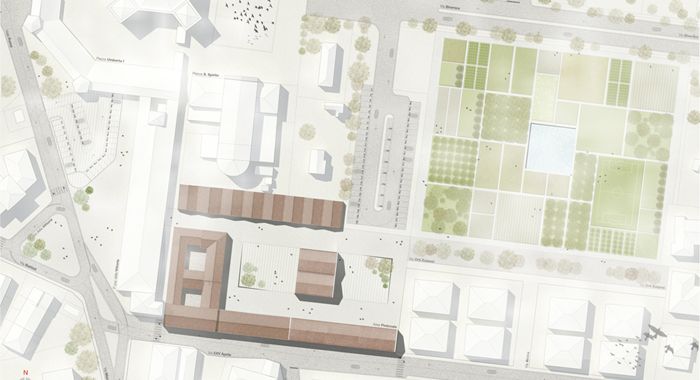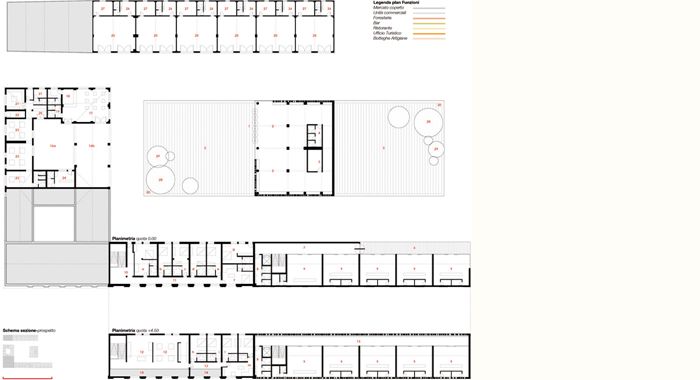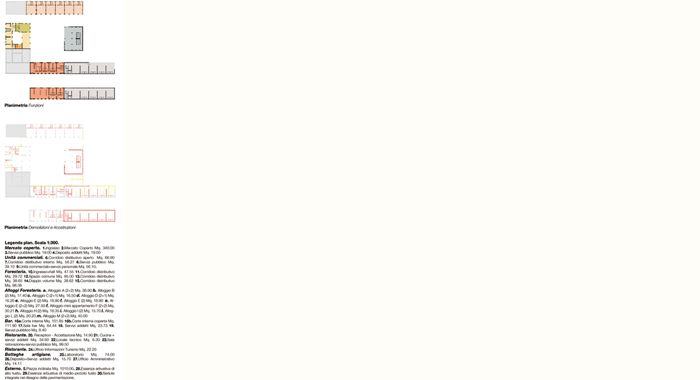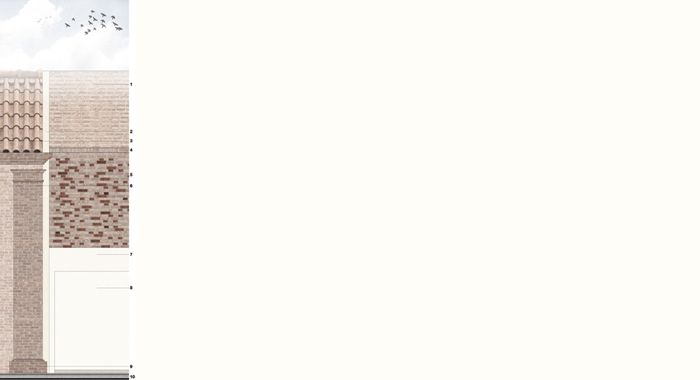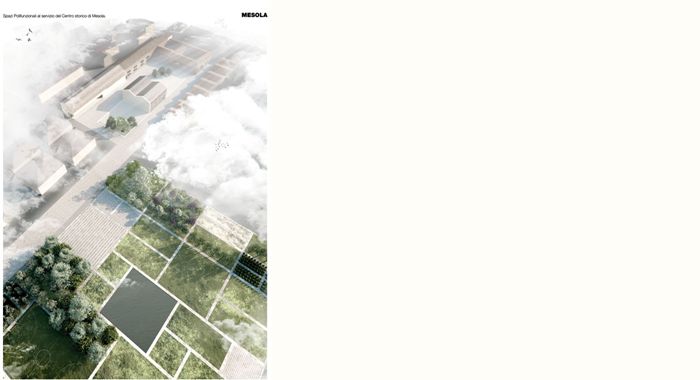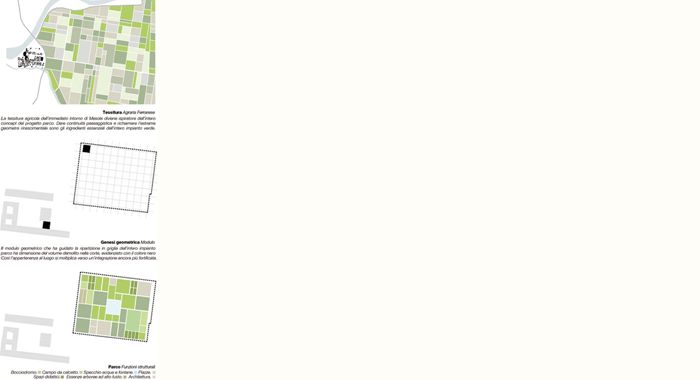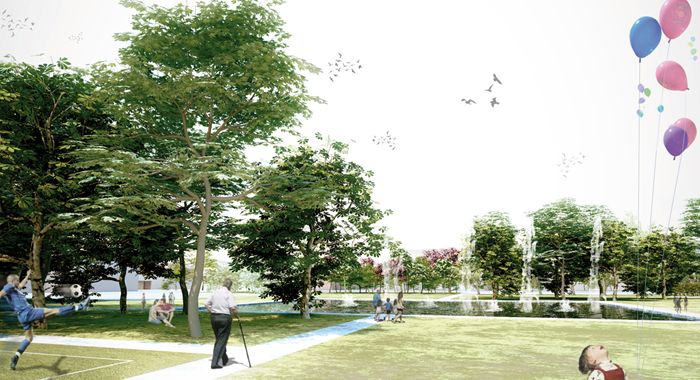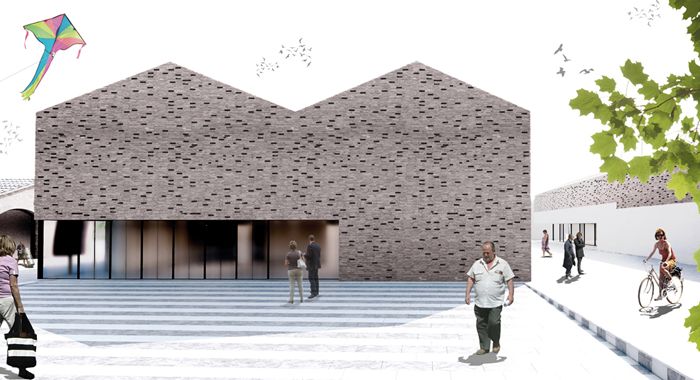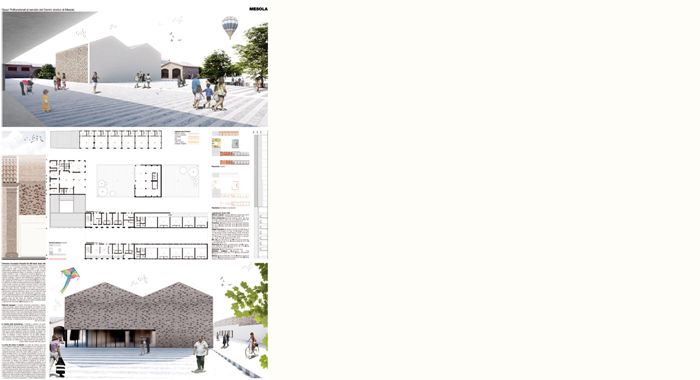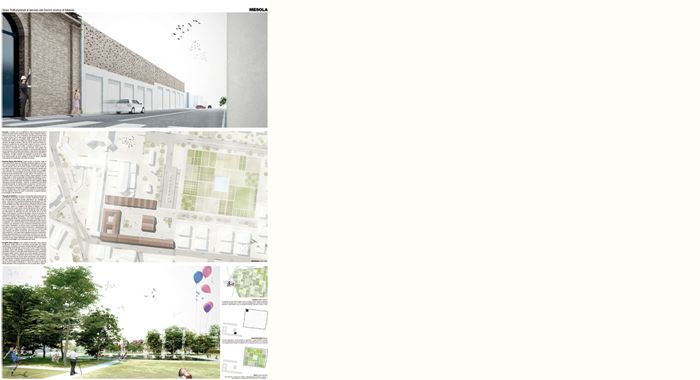Spazi polifunzionali al servizio del centro storico di Mesola
2012 project: Studio Batoni
Mesola, Ferrara
Il progetto per la riqualificazione degli spazi polifunzionali al servizio del centro storico di Mesola nasce da input e riflessioni diverse. Prima su tutte il luogo, carico di significati, che affonda le proprie radici in epoca romana: tra le tante ipotesi legate all'etimologia del nome Mesola, infatti quella più accreditata risulta essere di origine latina, “media insula”, indica come l'origine e lo sviluppo di questo antico insediamento sia legato al territorio. Alla fine del XV secolo gli Estensi acquistarono questa terra per trasformarla in riserva di caccia e costruire una residenza fuori città.
Come detto , il progetto si inserisce in un contesto storico e architettonico di notevole interesse, l'area oggetto del concorso si trova in pieno centro cittadino, in prossimità della parte più antica individuata dal Castello della Mesola e dalla Chiesa della Natività di Maria SS. L'intervento interessa tre diversi ambiti: Piazza della Vittoria, il complesso di edifici costituito dai magazzini comunali ed ex edifici Ersa, aventi accesso da vicolo Castello e da Via XXV Aprile e dall'area verde ubicata tra Via Biverale e Via degli Orti Estensi.
Il primo ambito di intervento, quello di Piazza della Vittoria, propone di fondere due diverse esigenze: parcheggio e area mercatale una volta alla settimana. Il progetto per la riqualificazione dell'area nasce dal concetto di piazza come spazio fruibile da una varietà di persone che la percorrono e la attraversano durante tutto l'arco della giornata. Un'area polifunzionale, utilizzata come parcheggio ma che possa essere sfruttata ed utilizzata anche per attività diverse: un luogo “aperto” che si relaziona con il contesto che lo circonda, si lega al tessuto urbano esistente, ma allo stesso tempo si rende riconoscibile ed individuabile attraverso la pavimentazione.
La nuova distribuzione planimetrica dei parcheggi, pur diminuendo il numero degli stessi, permetterà di avere maggiore fruibilità della piazza da parte dei pedoni, mettendo in evidenza le varie attività commerciali presenti. Un attento studio dei percorsi e dei flussi di persone che ruotano attorno alla piazza ha garantito una rigorosa e funzionale organizzazione degli spazi. La viabilità carrabile in prossimità della piazza e del Municipio è stata riorganizzata mediante tre isole spartitraffico che regolano il flusso dei veicoli e consentono un agevole ingresso al parcheggio e alle vie limitrofe. Nel secondo ambito di intervento, il complesso di edifici costituito dagli ex magazzini comunali, organizzato intorno ad una corte centrale, è stata possibile la creazione di un centro polifunzionale: una piazza centrale sulla quale si affacciano le varie attività commerciali, di servizio e ricettive. Negli edifici situati sul lato nord della piazza, hanno trovato collocazione sei botteghe artigiane; una semplice e funzionale riorganizzazione degli ambienti interni ha permesso di avere per ciascuna bottega una superficie destinata ai laboratori pari a 74 metri quadri, nella parte retrostante, è stato possibile ricavare il magazzino e i relativi locali accessori. Con questo tipo di intervento sono stati mantenuti inalterati i prospetti esterni e l'edificio non ha subito nessuna alterazione della parte strutturale. Gli edifici sul lato ovest della corte, su vicolo Castello, si presentano organizzati a loro volta su una piccola corte interna, alla quale si accede attraverso un porticato che serve da filtro tra la nuova piazza e gli edifici. Tale organizzazione, più contenuta e racchiusa su se stessa, ha suggerito di collocarvi gli spazi di ristorazione ed un punto informazioni. Un ambiente più privato e raccolto, nel quale poter organizzare un ristorante ed un bar, dando la possibilità a tali attività di utilizzare lo spazio aperto della corte e quello aperto-coperto del porticato. Nella nuova distribuzione interna degli ambienti, si è cercato di limitare al minimo gli interventi di demolizione dell'esistente pur garantendo un funzionale svolgimento delle attività di ristorazione; per quanto riguarda l'esterno degli edifici, sono state mantenute sostanzialmente invariate le aperture preservando così lo stato attuale. Per la collocazione dei locali ad uso foresteria sono stati sfruttati gli edifici nella parte sud della piazza che affacciano sia sulla corte interna che su via XXV Aprile. In tali ambienti, la presenza del doppio volume ha permesso di organizzare l'attività ricettiva su due livelli: al piano terra sono state sistemate sei camere, ciascuna dotata di bagno privato, e un mini appartamento con ingresso indipendente, sempre dalla corte interna, concepito per soggiorni più lunghi. Al primo piano troviamo altre quattro camere ed un ampio spazio comune adibito a cucina e spazio soggiorno per gli ospiti della foresteria. I locali adiacenti alla foresteria sono stati destinati alle attività commerciali. Attualmente questa porzione di edificio si presenta completamente slegata con il resto, sia per materiali che per altezze; con il nuovo intervento si è cercato di uniformare i prospetti su Via XXV Aprile, portandoli alla stessa quota della foresteria. Il nuovo centro destinato alle attività commerciali si compone di due elementi: un basamento, sulla traccia dell'edificio esistente, e da una parte superiore impostata sul basamento stesso, rappresentata dalla nuova costruzione che richiama nell'uso dei materiali gli edifici adiacenti. Una cortina di mattoni faccia a vista che corre fin sopra la copertura e che, attraverso un gioco di forature permette alla luce di filtrare dentro l'architettura. Un piccolo centro commerciale articolato su due livelli, dieci negozi (cinque per livello) di 56 mq ciascuno affacciati su un corridoio distributivo. Il cuore del secondo ambito di intervento è rappresentato dal mercato coperto e dalla nuova piazza. Il progetto propone di racchiudere l'idea di mercato, luogo di scambio e contrattazione, con il significato più particolare e ampio che individua nel mercato la piazza, o un altro luogo di aggregazione, di ritrovo e di socializzazione. Il concetto di mercato come spazio fruibile e vivibile da una varietà di persone che percorrono, attraversano, si muovono e sostano in un luogo che assume il significato di spazio collettivo. Per dare maggiore forza e centralità alla nuova struttura, è stata demolita una parte dei vecchi magazzini, consentendo al mercato di sganciarsi dal resto degli edifici. Per rendere funzionale il nuovo edificio è stato ampliato nella parte frontale verso il lato ovest; planimetricamente si sviluppa su una superficie di circa 380 mq su di un unico livello. Per uniformare il nuovo mercato al complesso nel quale si inserisce, la vecchia struttura è stata rialzata fino alla quota di 8,90 metri, allineato con gli altri prospetti; così come si è operato nella parte destinata alle attività commerciali, anche nel mercato coperto è stato mantenuto, come segno della preesistente struttura, il basamento, mentre nella parte relativa al nuovo intervento ritroviamo l'uso del mattone traforato. Il nuovo mercato coperto risulta ora inquadrato planimetricamente tra due piastre distributive che fungono da filtro e da tramite con il vicino parcheggio e con l'adiacente area verde anch'essa oggetto di intervento.
Il terzo ambito di intervento, l'area verde di Via Biverare, situata attorno al complesso monumentale del Castello della Mesola, si presenta come parte residuale dell'antico giardino Estense di pertinenza del Castello, un'area verde di circa 10.000 mq inserita nel tessuto urbano della cittadina. Il concept che ha guidato il disegno planimetrico del parco, parte dallo studio del territorio e più in particolare dal tessuto agrario intorno a Mesola. Un modulo quadrato che si ripete, si moltiplica, si divide, si assembla dando forma e movimento all'area: spazi verdi intervallati da piccole piazze pavimentate, aree alberate e siepi di gelsomino, parterre con bosso e uno specchio d'acqua centrale. Un forte richiamo al giardino rinascimentale italiano, non solo, la presenza di aree ricreative e didattiche, un campo da calcetto e spazi per attività educative, fanno di quest'area un vero e proprio parco urbano.
The project for the redevelopment of multifunctional spaces in the service of the historical center of Mesola comes from different inputs and reflections. First of all the place, full of meaning, which has its roots in Roman times: among the many hypotheses related to the etymology of the name Mesola, in fact the most reliable results to be of Latin origin, "middle island", indicates how the ' origin and development of this ancient settlement is linked to the territory. At the end of the fifteenth century the Este bought this land and turn it into a hunting and build a residence outside the city.
As mentioned, the project is part of a historical and architectural context of considerable interest, the area of the competition is located in the city center, near the oldest part identified by Mesola Castle and the Church of the Nativity of Mary. The action involves three different areas: Victory Square, the complex of buildings consists of warehouses and former municipal buildings Ersa, with access from alley Castello and Via XXV Aprile and parkland situated between Via and Via degli Orti Biverale Este.
The first area of intervention, one in Piazza della Vittoria, proposes to merge two different needs: car park and market area once a week. The project for the redevelopment of the square comes from the concept of how space can be used by a variety of people who travel through and throughout the day. A multifunctional area, used as a car park but it can be exploited and used for different activities: a place "open" that relates to the context that surrounds it, is linked to the existing urban fabric, but at the same time it can be recognized and identified through the paving.
The new planimetric distribution of parking spaces, while decreasing their number, will have greater usability of the square by pedestrians, highlighting the various commercial activities. A careful study of paths and flows of people circling the square has provided a rigorous and functional organization of space. The vehicular traffic in the vicinity of the square and the Town Hall has been reorganized through three traffic islands that regulate the flow of vehicles and allow an easy entrance to the parking lot and surrounding streets. In the second area of intervention, the complex of buildings comprising the former municipal store, organized around a central courtyard, it was possible to create a multi-purpose center: a central square overlooked by the various commercial, service and accommodation. In buildings located on the north side of the square, have been placed six workshops, a simple and functional reorganization of the interior allowed to have for each workshop a surface intended to laboratories of 74 square meters, at the back, it was possible to obtain the warehouse and its ancillary rooms. With this type of intervention have been kept unchanged exterior elevations and the building has not undergone any alteration of the structural part. The buildings on the west side of the court, of Castle Lane, you have organized themselves on a small courtyard, which is accessed through a porch that serves as a filter between the new square and buildings. This organization, more contained and enclosed on itself, suggested placed there spaces restaurant and an information point. A more private and intimate, where you can organize a restaurant and a bar, giving the opportunity for these activities using the open space of the courtyard and the open-covered porch. In the new layout of the rooms, we tried to minimize the demolition of the existing while ensuring effective conduct of the restaurant business, as regards the exterior of the buildings have been maintained substantially unchanged openings thus preserving the current state. For the location of the premises for guest use buildings have been exploited in the south of the square, overlooking either the courtyard that Via XXV Aprile. In such environments, the presence of the double volume has allowed us to organize the activity accommodation on two levels: on the ground floor were arranged six rooms, each with a private bathroom, and a mini apartment with separate entrance, always from the courtyard, designed for longer stays. On the first floor there are four more bedrooms and a large common area used as a kitchen and living space for guests of the guesthouse. The premises adjacent to the guesthouse were allocated to commercial activities. Currently this portion of the building has been completely disconnected with the rest, both for materials and for heights, with the new intervention was sought to harmonize the statements of Via XXV Aprile, bringing them to the same level of the guesthouse. The new center intended for commercial activities is composed of two elements: a base, on the track of the existing building, and an upper part set on the base itself, represented by the new construction that invokes the use of materials adjacent buildings. A curtain of facing bricks that runs up onto the roof and that, through a game of holes allows light to filter into the architecture. A small shopping center on two levels, ten stores (five level) of 56 m² each overlooking a distribution corridor. The heart of the second area of intervention is the market covered by the new square. The project aims to encompass the idea of the market place of exchange and bargaining, meaning more detail and identifies the broad market square, or another meeting place, meeting and socializing. The concept of the market as usable and livable space from a variety of people who walk, cross, move and stop in a place that takes the meaning of public space. To give more strength and centrality to the new structure, was demolished a part of the old warehouses, allowing the market to break away from the rest of the buildings. To make functional the new building was extended at the front to the west side; planimetrically spread over an area of about 380 square meters on a single level. To standardize the new market complex in which it occurs, the old structure has been raised to the height of 8.90 meters, in line with other reports, as it has operated in the part used for commercial activities, even in the covered market is was kept as a sign of pre-existing structure, the base, while in the part relating to the new intervention we find the use of brick pierced. The new market hall is now framed planimetrically distribution between two plates that act as a filter and as a liaison with the nearby parking lot and the adjacent green area is also subject to intervention.
The third area of intervention, the green area of Via Biverare, located around the monumental complex of Mesola Castle, looks like remaining part of the ancient garden belonging to the Estense Castle, a green area of about 10,000 square meters inserted into the tissue urban town. The concept that guided the design floor plan of the park, from the study of the area and in particular from agricultural fabric around Mesola. Form a square that is repeated, multiplies, divides, assembles giving shape and movement zone: green spaces interspersed with small paved squares, areas with trees and bushes of jasmine, with boxwood parterre and a water station. A strong appeal to the Italian Renaissance garden, not only the presence of recreational and educational areas, a soccer field and space for educational activities, make this area a true urban park.
